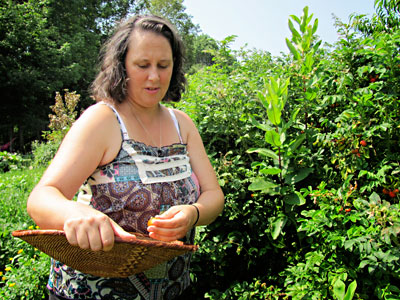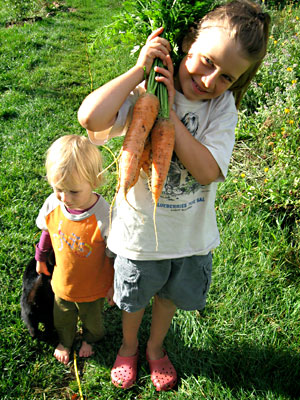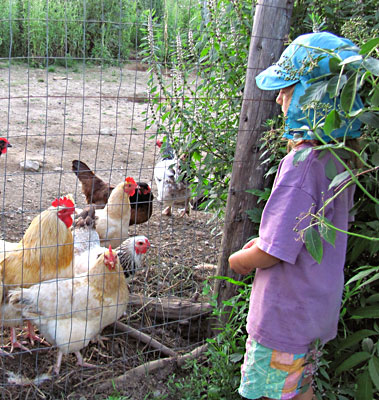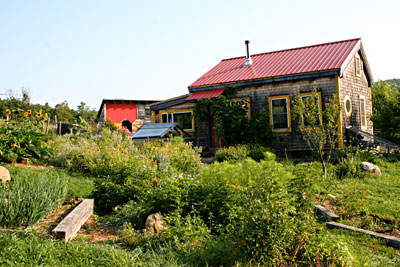 |
| Nyla Bravesnow of Many Hands Farm in Thorndike picks rose hips. Many Hands focuses on homesteading and permaculture on 2 cultivated acres. Photo by Sue Smith-Heavenrich. |
By Sue Smith-Heavenrich
If you visit Many Hands Farm in Thorndike, the first thing you notice is the abundance of flowers: sunflowers, coneflowers, beebalm and calendula. Lots of calendula. The air is filled with the hum of bees and the occasional chuckle of hens or bleat of a goat.
The farm, situated on 8 acres of sloping fields bordered by woods, is a work in progress, says Nyla Bravesnow. She and her partner, John Palumbo, looked for a place for nearly 10 years before they settled on this parcel.
“I wanted to find a place for a sustainable lifestyle,” says Bravesnow, who moved many times as a child. “I wanted a place to set down some roots.” She attributes some of this desire to reading the “Little House” books – especially “Farmer Boy” – and readily admits that the books influenced her decision to live more closely with the earth.
Palumbo grew up surrounded by food; his father owned a pizzeria. If you happen to drop by for breakfast, you’ll discover that he retains a passion for good food prepared well.
Before buying their own farm, the couple took advantage of the educational opportunities offered through MOFGA’s apprenticeship and journeyperson programs. This turned out to be important, as Bravesnow says she realized that she didn’t want to be a big producer. Their vision evolved to something more like a homestead: small and focused on family. They credit their mentor, Mark Fulford of Teltane Farm in Monroe, with expanding their knowledge and encouraging their farming efforts.
Many Hands Farm is aptly named. Since breaking ground in 2007, the farm has hosted a variety of volunteers who have donated their time, skills, plants, building materials and energy to help create what Bravesnow calls a “healing” place. Over any season you’ll find a mix of WWOOFers – volunteers through World Wide Opportunities on Organic Farms – who trade labor for meals and a bed, and urban refugees looking for low-stress respites to the daily grind.
 |
| Ara and Jonah, the youngest Many Hands farmers, with carrots. Photo courtesy of Many Hands Farm. |
Bravesnow measures success not in terms of market size or CSA memberships, but by the individual connections made with visitors. “We want to inspire people to use a small piece of land with permaculture and small buildings so they can maximize their use of space,” she says. She enjoys hosting volunteers and is always gratified when they tell her how they plan to use the skills they learned in their own backyards.
Producing Healthy Food
Of the 8 acres, 2 are currently under production. Vegetable beds are small and interplanted with heirloom and open-pollinated varieties, most ordered through Fedco, says Bravesnow. One raised bed grows a mix of corn, squash, and beans that could be anything from ‘Aunt Ada’s’ to ‘Tiger Eyes’, or ‘Hutterite’ soup peas.
Like everything on the farm, the garden beds grow naturally and in harmony with the landscape. There is no tractor at the farm, or a tiller. Instead of ripping the soil, Palumbo begins by mowing with a human-powered reel mower. Then he covers the spot with cardboard or animal bedding to kill the grass. He adds azomite as an amendment and layers bedding and compost until the bed is finished.
For Bravesnow and Palumbo, gardening spreads beyond the bed. They grow shade-tolerant crops in the woods: ginger, black cohosh and chestnuts. Weekly harvests provide a full complement of produce, berries and nuts for themselves and a small CSA and a local co-op. Their monthly lists of share items run from A-to-Z and include asparagus, dandelion greens, tomatoes and cucumbers, fiddleheads, berries and blossoms, herbs, eggs and goat cheese.
But there’s more than food in those bags. Bravesnow crafts calendula salve, arnica oil, lip balm and toothpaste powder. She mixes elderberry syrup, makes tinctures and teas, turns rose petals into beads and, later, the rosehips into jam.
Integrating Permaculture
Animals are integral to the farm and, like the plants, the breeds are heritage. Bravesnow selects gentle, calm breeds: Nigerian dwarf dairy goats; Welsh Harlequin and Ancona ducks, a variety that looks a lot like ‘Calypso’ beans with webbed feet; and a flock of nearly 40 chickens, including the heritage breeds Light Brahmas, Buff Orpingtons and Black Australorps.
The animals provide more than milk, meat, eggs. Through rotational grazing the goats keep the fields mowed and generate a steady supply of organic matter. The chickens provide pest control. Surrounding the garden is a chicken moat – a thin strip of land enclosed by parallel fences. During the day, the chickens patrol the perimeter of the garden, snacking on insects and weed seeds.
 |
| Jonah and the resident chickens. Photo by Sue Smith-Heavenrich. |
 |
| A view of the homestead. Photo by Sue Smith-Heavenrich. |
Chicken moats and interplanting are just a couple of the permaculture ideas integrated into the farm. Palumbo also incorporates biodynamic practices. Biodynamics is a spiritual and ecological approach to growing food. “I don’t know a ton of techniques,” he admits, but he was a Waldorf teacher for a while, and Rudolf Steiner, who founded Waldorf education, is the father of biodynamics. What Palumbo has learned has come through reading, conferences and experience. His biggest effort is focused on composting.
Composting the Biodynamic Way
Instead of traditional compost bins, Palumbo creates windrows that stretch 15 to 20 feet long and are about 4 feet high and just as wide. He builds the windrows a layer at a time, using animal bedding, vegetable scraps, manure and a bit of soil. If he has enough, he’ll layer in some finished compost. Then, using a watering can, he sprinkles the biodynamic preparation atop each layer. When the windrow reaches 4 feet in height, he shapes the top so that it is concave to catch water. Then he covers it with hay to keep in moisture.
Palumbo turns his windrows once and then lets them sit before using the compost. The “recipe” is fairly intuitive, he says, and depends on the resources at hand. “But we have a good amount to work with,” he chuckles.
A bit harder to put into words is the reverence and intention that goes into building things on the land – whether windrow or barn. “We share the land with others,” he says, “animals, microorganisms living in the soil.” His goal in integrating biodynamic techniques is to heal the earth by connecting with the energy and spirit of the earth.
Composting with Bunnies
While cleaning under one of the bunny hutches, Bravesnow had an idea: Wouldn’t it be wonderful if worms could just compost all these droppings? So last summer she began working on a bunny-worm composting bin. The idea is simple: Dig a pit beneath the bunny hutch and add redworms. The reality is a bit more complex.
Bravesnow’s bunny-worm system consists of a pit measuring 4 feet by 3 feet, and 2 feet deep. She lined the bottom and sides with hardware cloth to exclude rats and built a mesh cover over the top of the pit. While rabbit manure and bedding provide everything the worms need, Bravesnow tosses in occasional kitchen scraps to add variety to their diet.
The collaboration between lagomorph and annelid was so productive that Bravesnow was scooping out compost by late fall. But could the system survive a Maine winter? The rabbit hutches face south and are snugged between the potting shed and the side of a hoophouse. Bravesnow piled hay around the pit to insulate it from the cold and placed a window on top “like a cold-frame.” When she checked on them in December, the worms were doing well. “But like everything here, it’s an experiment,” Bravesnow explains. If successful, she hopes to be marketing bagged bunny compost in the future and – if she has time – creating a do-it-yourself bunny-worm compost kit.
For more information, contact John Palumbo and Nyla Bravesnow at Many Hands Farm, 269 Files Hill Rd., Thorndike, ME 04986. Learn more about their CSA and their long-term project to “un-own the land” at https://manyhandsfarm.weebly.com.
About the author: Sue Smith-Heavenrich watches bees and tends her organic gardens on a hilltop in upstate New York. When she’s not pulling weeds, she writes about environment and science for children and their families.
